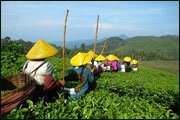Harvesting Tea

Harvesting tea is a very vigorous process that requires hard work and perseverance in order to coax the most out of the tea plant. Two processes exist for harvesting tea: course plucking and fine plucking. For both techniques harvesting tea is usually done by hand because machines damage the leaves too much for them to be of any use.
With fine plucking you harvest only the bud, second and third leaves so that you get the most from a harvest of tea. Harvesting tea needs to be done in the early morning. Women usually go and search for the young and tender buds that have silvery white fuzz on them. This type of harvesting tea makes very fine and delicate flavored tea. It is usually lighter and sweeter in taste.
Harvesting tea using the coarse plucking technique produces a lower quality of tea than fine plucking. In coarse plucking you will also harvest the bud but will include more than two leaves whilst harvesting the tea. This is generally done at a very fast pace. This technique of harvesting tea makes a stronger flavor tea than that of fine plucking.
The ideal conditions for growing and hence harvesting tea are usually at high altitudes with a good amount of rainfall. However, in some tea growing countries such as Sri Lanka (Ceylon) tea is also grown and harvested at lower altitudes, producing a different flavor and variety of Ceylon Tea. The ideal climate for growing tea also needs to have cooler mornings with a light mist to help shield the plants from the sun, as too much sunlight causes the tea to mature slower.
Growing Tea also demands a terrain of high acidic levels in the soil. A good harvest from a tea bush will generally be around three thousand tea leaves each year. Three thousand leaves sounds like a lot but in harvesting tea this quantity once fully processed, only makes about half a kilogram (one pound) of tea. One plant is barely sufficient for one person's personal use. To cater for masses harvesting tea must be done over many hundreds of hectares. Today most tea is grown and harvested on plantations, With China, India and Sri Lanka being the top 3 producers in the world.

In tea harvesting you will find there are normally two harvests of tea per year. The "First Flush" is in early spring and the "second flush" is in summer. The best times for harvesting tea will vary according to the tea variety which is to be harvested. To achieve additional tea harvest yields from individual plants they are kept young by pruning them and keeping them in the early stages of growth, thereby increasing the production of new buds and leaves for harvest.
Growing and harvesting tea is an art. It takes time and practice. If you want to try your hand at it, then you must be prepared to perceiver. Growing tea and harvesting tea can be compared to starting a vineyard and growing grapes - it takes years to be able to cultivate a good crop.
Disclaimer: The information contained on this site is not intended to replace the diagnosis, treatment, consultation and services of a qualified Medical Practitioner. All information presented is in summary form and intended only for informational purposes. Always seek immediate medical attention for any illness you may have and never disregard the advice from qualified Medical Practitioners as something you have read on this site (or related sites) could be misinterpreted.

